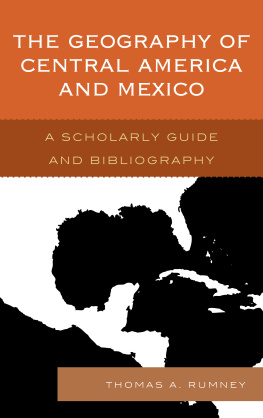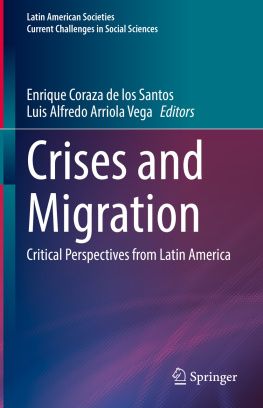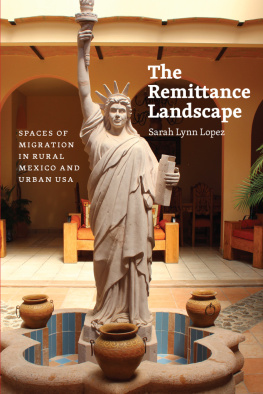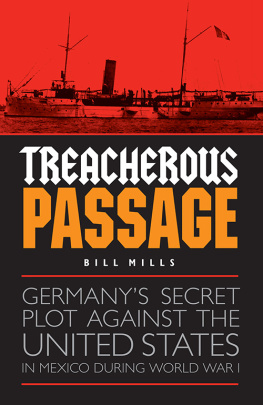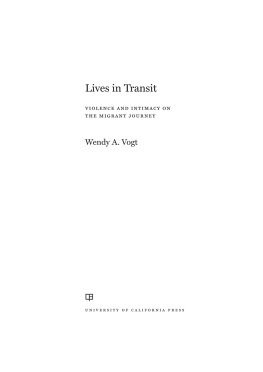Chapter 1
THE OPENING SCENE
A Journey Begins
Karla, who worked in a tourist caf owned by gringos, prepared gourmet coffees for the international backpackers and surfers who flock to the coast of El Salvador.).

Figure 1.1. Karlas Map
The risks and the uncertainties of the journey, as understood by Karla before she left home.
Nevertheless, imagining the journey proved to be a daunting task for her. Karla delivered the map to me nearly a month later with an explanation that she had changed her mind; it was too dangerous to travel clandestinely. In her map, dangerous animals lined the trail, symbolizing the travel risks. A mountain looms ominously in the distance, obscuring the path forward. The journey is uncertain because the adventure cannot be foretold. Despite (or because of) her worldliness and the experiences of her family, Karla knew it would be preposterous to predict the route she would need to travel. Thus, the mountains in her map symbolized her uncertainty about the path she would take. Yet within a year of drawing the map, a frightened Karla braved the journey anyway; she suddenly left for reasons that she never explained to me. Perhaps the lure of adventure overcame the monotony of a rural womans life. Perhaps one of her siblings offered her a once-in-a-lifetime opportunity to travel with an expensive coyote, and she seized the moment. Since such smuggling services could, at the time, cost $7,500 for a regular passage, it is easy to imagine that sponsorship for such pricey travel opportunities might be difficult to refuse. I did not have the opportunity to ask Karla about the motives for her sudden flight. Instead, through the images Karla posted on Facebook, I have followed her from a distance for years, watching her create a new home in the United States and raise her daughter, who was born after her arrival and thus is a U.S. citizen. With a bit of luck, Karla will avoid deportation and will not have to travel the migrant passage through Mexico again.
The survival plays necessitated by the migrant passage can make heroes, victims, and villains out of Central Americans, such as Karla, who must brave it. These survival plays are the performances that structure encounters among strangers under violent conditions, and they become a source of cultural and territorial mobility within the migration corridor. Nevertheless, the State sets the stage by imposing borders and generating risk and uncertainty for migrants crossing Mexico. These everyday scenes of migration unfold within a larger political theater, in which the intensification of migration policing and migrant suffering play to a U.S. audience. Taken together, survival plays and policing scenes depict a tragedy rather than an epic, often closing with senseless sacrifice instead of happy endings. For this reason, I hope that Karlas part in this spectacle is over.
To return to the image for a moment, the mountain motif in Karlas map is not just background setting serving an aesthetic purpose. The image is critical for understanding the plot structure of a clandestine journey from Central America to the United States. In her map, the mountains obscure the way forward, because each journey is unique. She cannot know what may lurk beyond. The past offers little guide to the future. While Karla trusted her siblings, she had doubted her ability to learn from their experiences in the borderlands. The route north through Mexico changes dramatically from one journey to the next, limiting the capacity to predict whether migrants arrive successfully in the United States or not.
Using a theatrical metaphor, this book tells the story of how people like Karla navigate in shadow and cope with a double-edged micropolitics of information; it is this double-edged informational politics that animates the plot and creates unexpected twists, moving people in new trajectories as they grapple with unknowns. Karla is rational, but to imagine a journey to the United States, she must navigate an almost impossibly difficult problem of uncertainty. While risk is the probability of a danger and its potential harm, uncertainty characterizes a dangerous situation without a known probability. A dynamic strategic setting and the accompanying clandestinitya necessity during the journey due to policing and criminal predationexacerbate uncertainty. In this setting, information is both a resource and a curse; migrants must learn past practices and protocols for negotiating the journey, but the very availability of this information renders it suspect. The spread of information about how and where to go may lead migrants north, but it may also lead police and criminal predators to migrants. As police and criminals attempt to intercept them, migrants cannot rely on information about past practices without reservation, even if reliable sources like trusted loved ones relayed that information to them. In fact, with the intensification of Mexican policing and criminal violence occurring since the mid-2000s, even experienced migrants and guides express bewilderment about recent changes along the route through Mexico.
Thus, in the shadow of Karlas mountains, as I contemplated their meaning, I studied two interrelated questions about migrant journeys:
- If the most experienced migrants and guides feel daunted by this uncertainty and violence, how do people attempt to move along the route with the barest of social or financial resources at their disposal?
- How do these wanderers, many of whom never arrive at their intended destinations, interact with people and places along the way, and what are the consequences for the societies through which they travel?
I argue in my answer that people improvise encounters with strangers and with the terrain to survive a dangerous and uncertain passage. Migration studies, focused primarily on the role of social capital as a mobility resource, have missed the importance of encounters among strangers as a survival resource. Nevertheless, during the journey, improvised performances of social scripts and improvised material practices become a resource for mobility. As we will see, migrants loose reenactments of these scripts and practices also potentially reinforce or destabilize identity and place markers. These reenactments generate social ambiguity. As a result, migrants encounters with people and places along the way restructure the route for the people that follow in their footsteps.
Importantly, this process unfolds whether migrants reach their intended destinations or not. Scholarship focused primarily on migrant destinations generally misses the story of the people who never reach them. A U.S.-only view of the migration process obscures the stories of people who never leave home, people who make failed journeys, and people who die or disappear en route. A view from the transit corridor, however, reveals the long-reaching shadow of the border for people who may never step foot in the United States.
Therefore, I analyze the journey and migrants improvised interaction with the transit corridor through which they pass. In this context, improvisation refers to an irreverent resourcefulnessa leveraging of conventions and codes for unanticipated purposes. By tracing these improvisations along the transit corridor from Central America through Mexico and into the United States, I show how fluid migration practices reshape the social landscape. Thus, I argue that migrants responses to their uncertain passage transform the possibilities of the nation-state and the world around us, albeit with as yet undetermined outcomes for borders and humanity. This book, along with Karlas map, is a portrait of underground globalization in action.


